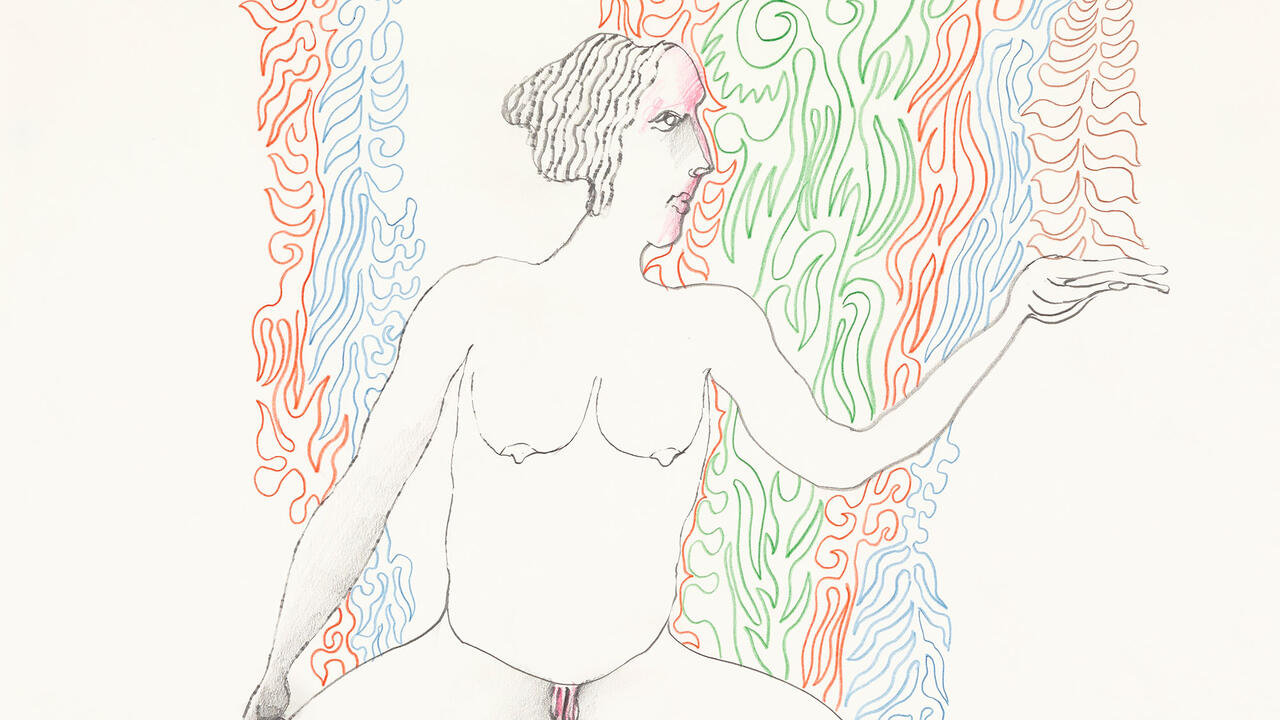Raffi Kalenderian’s Kaleidoscopic Compositions
At Galerie Peter Kilchmann, Zurich, the LA-based artist’s portraits harness a provocative tension between figuration and abstraction
At Galerie Peter Kilchmann, Zurich, the LA-based artist’s portraits harness a provocative tension between figuration and abstraction

It’s a simple, unfair slur, echoing over oceans for centuries, that America is shallow. Though an unjustified critique, this perceived lack of depth might be seen to hold a certain visual truth – at least from the flat, self-taught portraiture of the colonial period onwards. Over the past decades, the levelling of visual fields in figurative art has coalesced into a Los Angeles signature style, beginning with David Hockney’s iconic 1960s poolside compositions and running through to a group of loosely related contemporary painters working against foreshortening today. The city’s rise as a recognized cultural hub has made stars of hometown heroes such as Henry Taylor, Hilary Pecis, Jonas Wood and Raffi Kalenderian, whose jewel-toned depictions of friends and artistic peers fit securely into this school.

In his current show at Peter Kilchmann in Zurich, Kalenderian’s figures are subsumed by their chosen environments, belongings and workspaces. The neon-red highlights against the saturnine background in Diana (2021), for instance, draw more attention to the furnishings and to the character’s spotted dress than to the protagonist herself. It’s a device that has been employed throughout art history: the depiction of sumptuous fabrics and fancy dogs to signify grandeur and wealth in codes intended to be legible to the sitters’ class equals. The boho and bobo figures populating Kalenderian’s paintings are much the same, with their presumably designer lamps and patterned soft furnishings suggesting an exclusive, semi-homogenous culture of place, livelihood and time.

Yet, it would be a mistake to pigeonhole Kalenderian’s work as merely documenting the creative class. His paintings harness a provocative tension between figuration and abstraction that elevates them beyond content. The largest work on view, The Visit (After Valloton) (2021–22), is washed in a spectrum of red light that turns the interior into a zebra-print bagnio. The dancing figures become discoveries that the eye settles upon then finds anew. This effect is repeated throughout the show, as in Alyssa (2021–22), whose central form – a dead ringer for the disgraced art dealer Mary Boone when younger – ebbs and flows around a flat green couch and wild floral curtains. In comparison, Thomas McDonell in his Los Angeles Studio (2022) appears more staid, but the depicted back wall turns into a trippy, tubular tidal wave of frothy blues, greens and creams in which both subject and viewer can get lost. In other works, like Jess and Alondra (both 2022), light becomes a flowing and colourful entity, diminishing the separation between form, figure and ground. These intimate bedroom scenes are nearly washed away in gentle layers of fluorescent pinks and blues, capturing ghosts of moments in paintings that are beyond simple graphic deconstructions.

All of the paintings on display imply situations of creative living and working, incorporating the figures in ways soft and absolute within the décor, landscape and architecture. Whether as individuals or societies, all that we create has the power to overwhelm or outlast us. We’re not as central as we’d care to imagine to any given scene – even one of our own creation – yet, still we leave a mark. In Kalenderian’s continuation of the US impulse to reject perspective – from Grandma Moses to Andy Warhol – his social and professional circle provide him with the excuse to paint both the physical and emotive. These kaleidoscopic compositions manage to document and dream concurrently.
Raffi Kalenderian’s exhibitition at Galerie Peter Kilchmann is on view until 29 July 2022.
Main image: Raffi Kalenderian, Diana (detail), 2021, oil on canvas, 1.5 × 2.1 cm. Courtesy: the artist and Galerie Peter Kilchmann, Zurich; Photo: Fredrik Nilsen Studio, Los Angeles
























